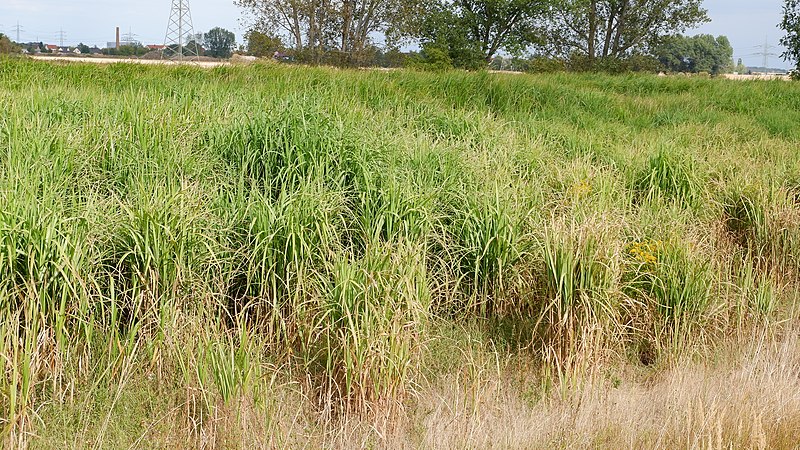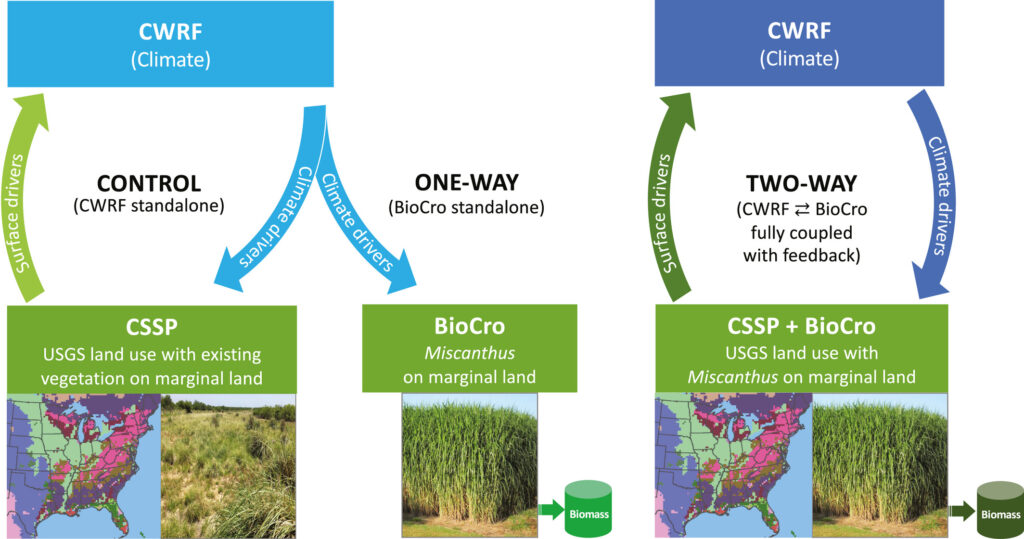The Intergovernmental Panel on Climate Change’s (IPCC) 2021 report predicted that global warming will cause the American Midwest to warm by 2-3°C by the mid-21st century, threatening much of the world’s food and feed crop production. However, a group of U.S. National Science Foundation-funded researchers have found that growing one plant could have cooling effects significant enough to cut warming in half.
A new study including ESSIC scientist Xin-Zhong Liang has discovered that growing Miscanthus x giganteus, a type of perennial biomass crop, has a strong likelihood of significantly lowering regional summer temperatures and the vapor-pressure deficit, while increasing rainfall and overall crop productivity. This work was published in Global Change Biology-Bioenergy with Liang serving as Lead Principal Investigator. The first author, Yufeng He, is a former ESSIC Postdoctoral Associate.
Miscanthus x giganteus, also known as giant miscanthus, has bamboo-like stems that can grow up to 3-4 meters. The plant is water efficient, non-invasive, and requires little fertilizer. It’s also able to grow on marginal land, or land that has little or no agricultural or industrial value due to poor soil or other undesirable conditions. The U.S. Heartland, which has much marginal land that goes mostly unused or in extensive grazing, provides the perfect conditions for miscanthus.

The researchers, based at the University of Maryland, College Park and the University of Illinois, Urbana-Champaign, interfaced a dynamic crop growth model with a regional climate model to enable two-way feedback between the climate of the Midwest and the crop. The new modeling framework fills the gap of previous works that ignored the dynamic feedback, and provides new insight with wide-reaching implications for nature-based mitigation strategies on global warming, environmental conservation, food crop and bioenergy production, and agricultural sustainability.
“Growing perennial grasses on marginal land not only can reduce soil erosion, restore carbon stocks, and provide feedstocks for biofuels and bioproducts, but also can represent an effective mitigation strategy to contain regional climate change, preventing the U.S. agricultural heartland from the warming-and-drying trend as currently projected.” commented Liang.

The models found that the miscanthus did more than just cool the land – it also significantly increased summer precipitation. In the Midwest simulations, summer precipitation increased 14-15%; in the Southern Heartland, it increased 14-16%. Unlike the temperature changes, which are greatest in the areas with the largest amounts of miscanthus, the precipitation changes can occur hundreds of miles beyond these areas due to teleconnections resulting from mesoscale atmospheric circulations. This causes both increases and decreases in precipitation depending on location. However, in the major areas of food and feed production in the Heartland, precipitation is predominantly increased. These climatic impacts occur throughout the entire growing period of miscanthus, which spans from April to October in the Midwest.
“Growing perennial grasses on marginal land can not only enhance local environmental conservation but also improve both regional climate and agricultural productivity on a broader scale,” said Liang, “Neglecting crop-climate interaction would underestimate the overall impacts of land use changes and thus likely misrepresent the agricultural system resilience under climate change.”
The team is now working on a follow-up study that discusses allocating multiple bioenergy crops on U.S. marginal land. Recently, they found that energycane, a genetically modified variation of sugarcane, is more productive in southern states while miscanthus is better in the north. They are now researching how jointly planting the two biomass crops on their optimal growth areas of marginal land may amplify the positive feedback.
“We are very excited by the opportunity from the food-energy-water nexus framework to identify climate-smart farming practices that can sustain U.S. agricultural productivity,” Liang said.
Liang is an ESSIC/CISESS Professor and has been working at the University of Maryland since 2011. He received his Ph.D. in Atmospheric Dynamics at the Chinese Academy of Sciences in Beijing in 1987.
To access the paper, click here: “Perennial biomass crops on marginal land improve both regional climate and agricultural productivity”.






